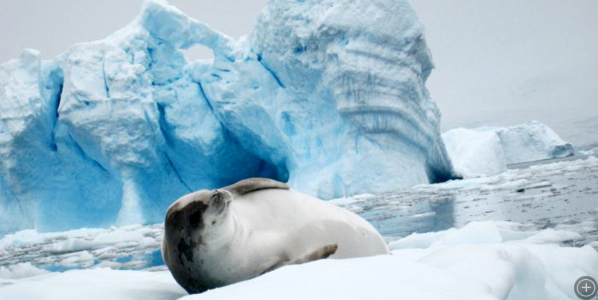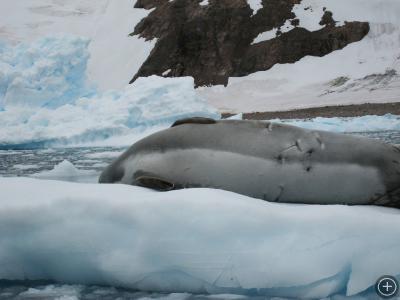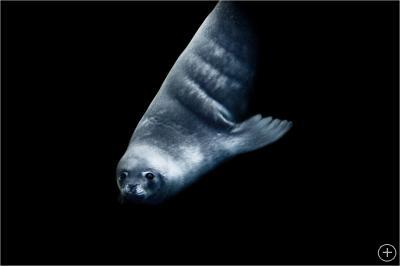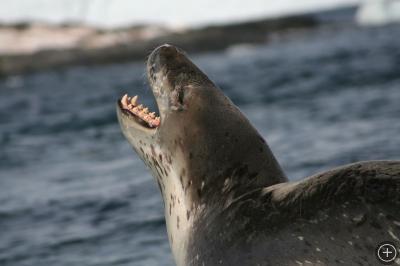Antarctic Seals
Here’s a look at three of Antarctica’s seal species—crabeaters, Weddells, and leopards—which make a living in three different ways.
Crabeater Seals
Found amid the pack ice during the Antarctic spring and summer, crabeaters primarily hunt krill—not crabs. They’re filter feeders, like many whales, but instead of baleen plates to trap the krill, they have extraordinarily complex teeth that do the job for them. They swim open-mouthed through a school of krill, sucking in water along with the tiny crustaceans. Then they close their teeth together, trapping their prey, while deep spaces in their teeth let the water out. They feed mostly at night, diving continually for many hours, and can reach a depth of about 100 feet (30 m). Pups are born in the spring and are weaned in just three weeks. After that they’re left to forage on their own.
As winter approaches, the crabeaters head for lower latitudes. They’re seen as far north as the southern coasts of South America, Africa, and Australia.
Crabeater pups are preyed on by leopard seals, and many adults have parallel scars that attest to an encounter with a leopard seal in their youth. The adults weigh about 440 to 660 pounds (200 to 300 kg) and usually aren’t bothered by the leopards. But they’re no match for the type B orcas that dine on both seals and penguins.
The crabeater is the most abundant seal species in the Southern Ocean. Their population size isn’t known with any precision, but it’s thought that they number in the millions. The decline of the baleen whales has left more krill for them to feed on and has probably led to an increase in their numbers.
Weddell Seals
Although they’re large animals, weighing in at about 1,000 pounds (455 kg), the Weddell seals are regarded as downright cute. Adjectives such as “appealing” and “smiling” are often applied.
These seals, named for nineteenth-century British explorer James Weddell, are year-round inhabitants of the fast ice that surrounds the Antarctic coast, spending much of their time below the ice. They dive through breathing holes to hunt, and they’ve developed some interesting strategies for doing so. They dive deeply, then turn upward to find fish backlit above them. They also blow into cracks in the ice, which startles fish into leaving their safe havens. We know about these hunting techniques from videos taken by the seals themselves via small cameras attached to their heads by researchers. Their penchant for hunting under the fast ice offers good protection from their main predators, orcas and leopard seals, who can’t reach them there.
During the cold Antarctic winter, the Weddells keep their breathing holes open by chewing at the ice, although this activity takes its toll on their teeth, which may ultimately shorten their lives. They may use tidal cues to determine good times to hunt, but how they find their prey or navigate back to their breathing holes in the dark is a mystery.
In September and October, pups are born on the fast ice near all-important breathing holes. When they’re a week old, pups start learning to swim and to haul themselves out onto the ice. They’re weaned at six weeks, after which they hunt on their own.
Weddell seals mainly eat fish. Among their favorites are the Antarctic toothfish—which makes its way to market as the Chilean sea bass—and the Antarctic silverfish. But in the last few years a fishing industry targeting the toothfish has been established in Antarctica’s Ross Sea, the last part of the world’s ocean that has not been overfished. The toothfish competes with the seals for silverfish, so what will be the effect on the Ross Sea Weddell population as toothfish are taken by the fishery?
Biologist David Ainley wants to find out. As he wrote in a November 2007 dispatch,
The idea is that as more Chilean sea bass are taken from the Ross Sea, the seal population should change. Seal numbers would either decline because there are fewer sea bass to eat or increase because with fewer sea bass there would be more silverfish for the seals to eat.
David, along with seal researchers from Montana State University, has proposed a study to monitor the Ross Sea Weddell seal population and to determine the effects of fishing on the Ross Sea ecosystem. Currently, there are about 32,000 Ross Sea Weddels out of a total Antarctic population that’s estimated at 800,000.
Leopard Seals

Leopard seals have a lean body that’s about 10 feet (3.2 m) long and a somewhat reptilian head. Photo by Nick Russill.
A leopard seal has more in common with the cat that it’s named for than just its spots. Both are top predators that are swift, shrewd, stealthy, and strong.
During the austral summer, leopard seals are most commonly found near the edges of the Antarctic pack ice. They lie in wait just under the ice for a hapless seal pup or an unwary penguin to venture into the water, then quickly attack with their large mouths and powerful jaws. They’re also known to leap onto the ice to grab their prey and drag it into the water.
These seals can eat almost anything, and their teeth will tell you why. Their canine teeth are long and sharp like those of a cat, ideal for catching penguins and small seals. But their molars form a sieve, like the teeth of the crabeaters, so they, too, can filter krill from the sea. They also eat fish and a variety of other marine creatures, but researchers have noticed that individual leopard seals seem to have distinct food preferences, subject to availability.
The population size of the leopards may be something like 200,000, but it’s hard to make a tally of solitary seals spread throughout a vast inaccessible area. For the same reason, very little is known about their breeding behaviors or how their pups are raised.
During the winter the leopards tend to be found near the coasts of sub-Antarctic islands, with the juveniles often seen farther north. But these seals are known for their wandering ways and have been sighted near the coasts of South America and Africa, and even in the waters off Heron Island, which is at the Tropic of Capricorn.
Leopard seals are hunted by orcas, but this doesn’t threaten the species. Because they’re apex predators, the future health of the leopards will probably be determined by the general health of the Antarctic ecosystem.












